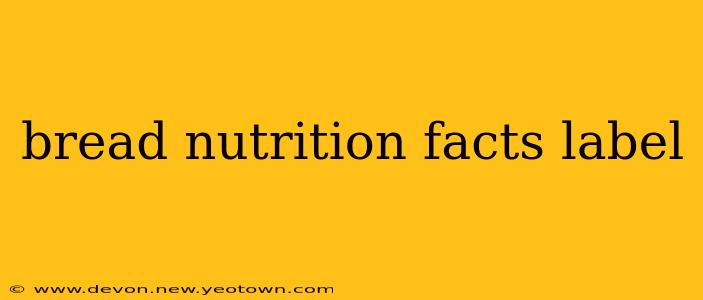Bread. The humble loaf, a staple in kitchens worldwide, and a source of both comfort and controversy. But how much do we really know about what's in that slice we grab for breakfast, lunch, or a quick snack? Let's dive into the often-overlooked world of the bread nutrition facts label, unraveling its secrets and empowering you to make informed choices.
My name is Sarah, and I've spent years researching food science and nutrition. I've witnessed firsthand how seemingly small differences in ingredients can significantly impact our health. This post aims to equip you with the knowledge to confidently navigate the nutrition label jungle, focusing specifically on bread.
What are the Key Things to Look for on a Bread Nutrition Label?
The nutrition facts label is your bread's nutritional passport, detailing its ingredients and their impact on your body. The most crucial aspects to focus on are:
-
Serving Size: This is the baseline for all the other information. Pay close attention! A serving might be one slice, half a roll, or even a fraction of a loaf, depending on the product. Understand the serving size to accurately gauge the nutritional value of your portion.
-
Calories: How many calories are you consuming per serving? Consider this in the context of your daily caloric needs.
-
Total Fat, Saturated Fat, and Trans Fat: Fat is essential, but too much, especially saturated and trans fats, can negatively impact heart health. Look for bread with lower levels of these fats.
-
Cholesterol: Unless the bread contains added cholesterol (which is rare), this value will likely be zero.
-
Sodium: Many breads contain significant amounts of sodium. High sodium intake can contribute to high blood pressure. Individuals with hypertension should be particularly mindful of this.
-
Total Carbohydrate, Dietary Fiber, and Sugars: Carbohydrates are the primary energy source in bread. Dietary fiber is crucial for digestive health and can help regulate blood sugar levels. Added sugars contribute empty calories. Opt for breads with higher fiber and lower added sugars.
-
Protein: Bread provides some protein, although it's not its primary source. Check the protein content if protein intake is a concern.
How Many Calories Are in a Slice of Bread?
The caloric content of a slice of bread varies significantly depending on the type of bread. A slice of white bread might contain around 70-80 calories, while whole-wheat bread could contain slightly more, often around 80-90 calories. However, this can fluctuate widely based on brand and ingredients. Always refer to the specific nutrition facts label on the package.
What is the Best Bread for Weight Loss?
This is a question I hear often! For weight loss, focusing on whole-grain bread is typically recommended. Whole-grain breads are generally higher in fiber, which promotes satiety (feeling full) and aids digestion. The higher fiber content can also help regulate blood sugar levels, preventing energy crashes that can lead to overeating. However, portion control remains key even with healthier bread choices.
Is White Bread Healthy?
White bread, while convenient and often preferred for its softer texture, is generally lower in fiber and nutrients compared to whole-wheat bread. The refining process strips away much of the bran and germ, removing valuable nutrients. While not inherently unhealthy in moderation, it's generally recommended to opt for whole-grain alternatives more frequently for better overall health benefits.
What Bread Has the Least Sugar?
Finding bread with minimal added sugar requires careful label reading. Look for breads with minimal or no added sugars listed in the ingredients. Whole-grain and sourdough breads often have naturally lower sugar content compared to commercially produced white breads and some sweeter varieties.
Understanding the Ingredients List: What Should I Look Out For?
Beyond the nutritional information, the ingredients list is crucial. Look for breads with whole grains (like whole wheat, oats, or rye) listed early in the ingredient list. Be wary of excessive added sugars, high fructose corn syrup, and partially hydrogenated oils (trans fats). A simpler ingredients list is generally a good indicator of less processed bread.
Choosing the right bread involves a bit of detective work, but armed with the knowledge from this guide, you'll be well-equipped to navigate the supermarket aisles with confidence. Remember, the key is mindful consumption, understanding the nutritional information, and making choices that align with your individual dietary needs and health goals. Happy bread-choosing!

